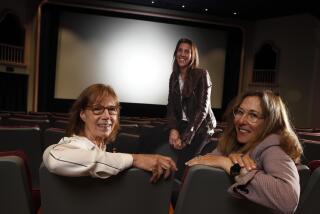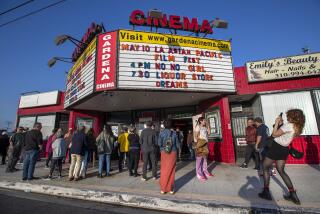Drive-in films bounce back, literally
After a 10-year intermission, drive-in movies are returning to Orange County, courtesy of an inflatable silver screen.
Tonight in Costa Mesa, a 300-car theater -- and unofficial backseat romance research center -- will flicker to life in a parking lot at the Orange County Fairgrounds.
Bankrolled by four baby-boomers, the Star-Vu Drive-In plans to operate year-round, except during fair season.
The last such venue, Westminster’s Hi-way 39 theater, closed in 1997 to make room for a Wal-Mart.
The Star-Vu, with its inflatable screen, represents a quirky new breed of outdoor cinema -- and the owners hope to franchise the concept to other cities.
Bundled in blankets with his wife and two children at a sneak preview Thursday night, Patrick Munoz said he would certainly be a repeat customer.
“This is great,” the Newport Beach resident said, recalling that he last attended a drive-in 25 years ago but was more interested in his date. “I’m pretty sure I don’t remember what the movie was.”
If successful, inflatable screens could reinvigorate the drive-in industry, born 75 years ago in New Jersey when inventor Richard Hollingshead Jr. strung a sheet between two trees and plopped a 1928 Kodak projector on the hood of his car.
After testing with lawn sprinklers to simulate movie-watching in the rain, Hollingshead patented the idea and opened the first roofless movie palace. By 1958, the peak of the drive-in binge, the number of cinemas topped 4,000 nationwide.
Some had carnival rides and miniature golf to help keep kids entertained.
By 1977, the number of drive-in theaters had dipped below 3,000, partly because Congress established national daylight-saving time in 1966, forcing outdoor cinemas to start films an hour later and clobbering attendance by families with small children.
The rise of videocassettes, cable TV and multiplex theaters compounded the industry’s woes, as did skyrocketing land values. Today, drive-ins are an endangered species, numbering about 400.
So, when “Shrek the Third” beams onto the Star-Vu’s 65-foot-wide screen shortly after 8 tonight, Southern California will boast its first new drive-in since 1975, according to drive-ins.com. That was when the Winnetka 4 opened in Chatsworth (it’s now an indoor, 21-screen megaplex.)
Adding a touch of irony to Star-Vu’s debut is its location. For decades, drive-in theaters held daytime swap meets to boost profits. Now, the situation is reversed: The home of a weekend swap meet -- the fairgrounds -- will open a drive-in theater.
Making it all possible is a 2,000-pound hunk of Italian plastic, inflated with British fans and cloaked with a French movie screen that is also used in indoor theaters. The contraption was reportedly invented by a German in 1994 and popularized in America, in part, by a Mormon missionary who saw one in Switzerland and dropped out of Brigham Young University to launch an inflatable movie screen rental company.
Star-Vu is one of just two U.S. drive-ins using air-powered screens, according to co-owner Bob Deutsch, whose Maryland company specializes in outdoor cinema equipment and rentals. The other theater is in York, Pa.
The screens inflate in about 15 minutes and are designed to withstand winds up to 40 mph.
“The first time I saw one, I was flabbergasted,” said Deutsch, who had previously set up outdoor film festival screens with scaffolding that took two days to rig. “I bought it on the spot.”
Punctures can be fixed by crawling through a zippered door while the screen is inflated and patching the hole with a heat gun, he said.
Kamikaze moths, dust and other grime can be washed off by laying the screen on its back, deflating it and having people in socks walk the surface with buckets of soap and water.
Prices for the imported screens range from $4,500 for a 16-foot-wide model to $223,000 for a TV-like cube that also works in broad daylight.
Knockoff versions for home use have also hit the market. Gemmy Industries recently introduced a 13-foot blow-up movie screen that retails for $200.
The only thing missing is inflatable popcorn.
*
(BEGIN TEXT OF INFOBOX)
Rare breed
Forty years ago, Southern California had 107 drive-in theaters. Today, just 10.
Motor Vu Twin, Imperial: opened in 1940.
* Rubidoux, Riverside: 1948.
* Smith’s Ranch, Twentynine Palms: 1954.
* Vineland, city of Industry: 1955.
* Mission Tiki, Montclair: 1956.
* South Bay, Imperial Beach: 1958.
* Santee, Santee: 1958.
* Van Buren Cinema 3, Riverside: 1964.
* Skyline, Barstow: 1966, closed in 1987, reopened in 1996.
* Star-Vu, Costa Mesa: Opens tonight.
--
Sources: Star-Vu Drive-In, drive-ins.com
--
*
(BEGIN TEXT OF INFOBOX)
Now showing (Orange County)
A new drive-in theater opens at the Orange County Fairgrounds tonight and features a movie screen stretched like canvas across a giant, inflated frame. The theater can accommodate about 300 cars.
Inflatable frame: 72’ wide x 46’ tall. The structure is made of PVC-coated nylon tubes 10 feet in diameter that are welded together.
Screen size: 65’ x 33’. The screen is stretched over the frame and attached with elastic ties.
Inflation time: 15 minutes, using two air blowers.
Projector: Similar to an indoor movie theater projector, but with a stronger, 7,000-watt lamp.
Wind resistance: Up to 40 mph. The 2,000-lb. screen and frame are tied to four steel cables anchored by concrete blocks.
What supports the screen: Just air pressure.
Speaker system: FM broadcast through car radio.
Tickets: Ages 13 and older $8.50; child 5 to 12 $5; 4 and younger free. Shows at 8 and 10:30 p.m. daily except during the Orange County Fair (July 13-Aug. 5).
--
Pump it up: Star-Vu Drive-In co-owner Bob Deutsch says during inflation the screen “looks like a big whale that grows and grows and grows.”
Orange County Fairgrounds and Exposition Center
--
Sources: Outdoor Movies, Orange County Fairgrounds and Exposition Center


